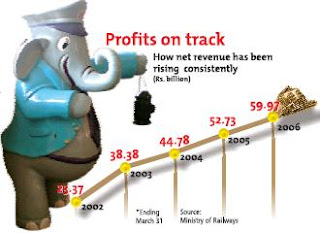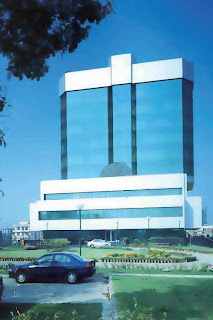IIPM MANAGEMENT INSTITUTE
Lalu Prasad
 Yadav emerges as a transformational CEO by launching strategic initiatives that are fashioning Indian Railways as a 21st century corporation...
Yadav emerges as a transformational CEO by launching strategic initiatives that are fashioning Indian Railways as a 21st century corporation...There would have been snide sniggers last year if someone had the temerity to suggest that Railway Minister Lalu Prasad Yadav of Bihar fame would emerge as one of the hottest CEOs of India Inc.. Yet, the rambunctious Yadav is transforming Indian Railways into a consumer-oriented company that’s pursuing all kinds of corporate strategies and relentlessly chasing profits
So there was this newspaper that once ran a photograph of Lalu standing with a herd of buff aloes; with a caption that mentioned, “Lalu, third from left !” And there lies the wonder of Lalu Prasad Yadav, the politician and now Union Minister for Railways; a man whose branding has always traditionally hovered around buff aloes and dairy products. But now, with his valiant transformation attempts on the Indian Railways, Lalu Prasad will perhaps be now known as a true blue, no holds barred Chief Executive Officer; and perhaps one, which India Inc. would look up to... Well, one day... And as we said, perhaps.
Laying down his corporate vision as he presented the Railway Budget to the Parliament, Lalu Yadav stated: “The general perception so far has been that Railways’ finances cannot be improved without increasing second class passenger fares. But my approach is entirely different. In my view, improvements can only be brought about by raising the quality of services, reducing unit costs and sharing the resultant gain with customers. Therefore, instead of following the beaten path, we decided to tread a new one.” The Railways will never be the same again. What exactly has the colourful Minister done to make analysts drool over the transformation of Indian Railways from a government department to a 21st century corporation that understands and executes strategy with precision? Lalu Yadav seems to have mastered two management precepts: The Railways needs to increase long term profitability; and the Railways needs to increase market share. Most of the bold and innovative initiatives unleashed by Yadav revolve around these two goals. Even more important, while previous CEOs (Railway Ministers) have relied on populist schemes for passengers, this CEO has actually focused on the less glamorous freight business to refashion the future of Indian Railways.
An
 overwhelmingly dominant player in the Indian freight business once upon a time, Indian Railways has been steadily losing market share to rival operators. From a huge 80% of the freight market in 1947, the Indian Railways has nosedived to about 20%, with road transport operators and companies taking the business away from Railways. This year, Lalu has initiated never before seen competitive strategies to battle competition; and our man Lalu doesn’t seem interested in taking prisoners.
overwhelmingly dominant player in the Indian freight business once upon a time, Indian Railways has been steadily losing market share to rival operators. From a huge 80% of the freight market in 1947, the Indian Railways has nosedived to about 20%, with road transport operators and companies taking the business away from Railways. This year, Lalu has initiated never before seen competitive strategies to battle competition; and our man Lalu doesn’t seem interested in taking prisoners.Railways will now offer a loyalty discount to consumers who transport more goods on freight trains; given the fact that almost 80% of Railways’ revenues are contributed by freight. There will also be big differentials between peak and off season rates with off season discounts of up to 30%. Most significantly, private companies are being encouraged to invest capital in an ‘own your wagon’ scheme. These investors will get preferential treatment for freight movements. No wonder, India Inc is lavishing praise on Yadav! Says Amit Mitra, Secretary General, FICCI: “I think it is a very forward looking & market oriented budget. I would say even pragmatic budget,” pointing to Lalu’s initiative of allowing private firms to run container trains under the Indian Railways.
Another move is the construction of dedicated freight corridors that will connect the eastern and western seaboards of India. Lalu is investing Rs.220 billion in these corridors which, once completed, will drastically reduce the time to distance ratio, giving Railways a strategic edge over road transport.
The
 quest for increased market shares – and to fight low cost air carriers – can be seen even in the passenger segment. Though questionable on being a pro-rich move rather than being pro-poor, Lalu has ensured an 18% drop in the price of AC-2 tier tickets, while AC-3 tier prices have dropped by 10%. Perhaps to counter criticism, Lalu has also launched the Garib Rath, an economy train service connecting major Indian cities. The AC- 3 tier prices in these trains will be 25% lower than other trains. Analysts clearly seem to share Lalu’s optimism that this will lead to improved market shares.
quest for increased market shares – and to fight low cost air carriers – can be seen even in the passenger segment. Though questionable on being a pro-rich move rather than being pro-poor, Lalu has ensured an 18% drop in the price of AC-2 tier tickets, while AC-3 tier prices have dropped by 10%. Perhaps to counter criticism, Lalu has also launched the Garib Rath, an economy train service connecting major Indian cities. The AC- 3 tier prices in these trains will be 25% lower than other trains. Analysts clearly seem to share Lalu’s optimism that this will lead to improved market shares.So much for market shares! CEO Lalu has also been paying a lot of attention to the bottom lines in the past one year. Last year, the Railways increased by 4 to 8 tonnes the load carried by each wagon. An increase of just one tonne per wagon translates into 10 million tones more of freight carried without an extra penny increase in costs. As in business process re-engineering, Lalu has managed to increase freight loading capacity by 100 million tonnes without spending any money and generating an additional Rs.50 billion in revenues. Not surprisingly, this has been largely responsible for the organisation declaring a surplus of more than Rs.110 billion in fiscal 2005- 06, despite a substantial increase in input prices of diesel and electricity. The prospects for the fiscal year 2006- 07 look even brighter still.
That’s because the capacity of each wagon is being increased from 64 tonnes to 70 tonnes this year. In a few years’ time, Lalu plans to increase that to 80 tonnes per wagon. By that time, Lalu hopes to have completed the dedicated freight corridors linking east and west, which will dramatically reduce travel time for long distance freight trains, and thus sustaining increased profitability.
While
 the freight business will deliver the big bucks, Yadav has taken smart steps to reduce losses even in the passenger segment. The most important of these is the decision to increase the number of coaches in long distance trains to about 24 (from 16 coaches at most). The addition of these coaches will enable waitlisted passengers to travel, adding Rs.2 billion to the kitty. Yet another innovative measure is the optional upgrading of normal passengers into the AC class when seats in AC class go vacant, giving another similar Rs.2 billion. CEO Yadav also kick-started a scheme where services like catering will be auctioned through bidding. This has resulted in a 56% revenue increase in this segment to Rs.13 billion in 2005-06.
the freight business will deliver the big bucks, Yadav has taken smart steps to reduce losses even in the passenger segment. The most important of these is the decision to increase the number of coaches in long distance trains to about 24 (from 16 coaches at most). The addition of these coaches will enable waitlisted passengers to travel, adding Rs.2 billion to the kitty. Yet another innovative measure is the optional upgrading of normal passengers into the AC class when seats in AC class go vacant, giving another similar Rs.2 billion. CEO Yadav also kick-started a scheme where services like catering will be auctioned through bidding. This has resulted in a 56% revenue increase in this segment to Rs.13 billion in 2005-06.Yet, there is the last frontier that CEO Lalu has to cross. The Railways owns the largest amount of real estate in the country. If Lalu can find a way to leverage this real estate strategically, this rustic politician can join the pantheon of corporate visionaries. Clearly, Lalu Yadav and Railways are on a roll. All that it has taken is to borrow some simple and fundamental principles of modern corporate management and transplant them into his organization. No wonder, an obsolete and effete government department is being transformed into a charged up and aggressive corporation, without the huff s & the puff s of the past. Indian Railways is alive; and the buff alo king leads!
For Complete IIPM Article, Click on IIPM Article
Source : IIPM Editorial, 2007
An IIPM and Professor Arindam Chaudhuri (Renowned Management Guru and Economist) Initiative
For More IIPM Article, Visit Below....
Management Institute ! IIPM Info ! IIPM Business School ! IIPM India ! IIPM Management Education ! IIPM Management Introduction ! IIPM Management ! IIPM Management Courses ! IIPM Centers !

